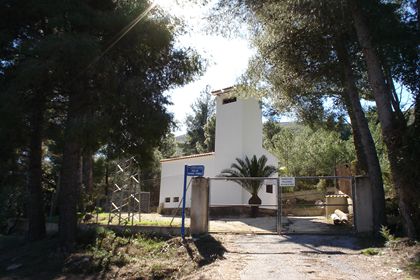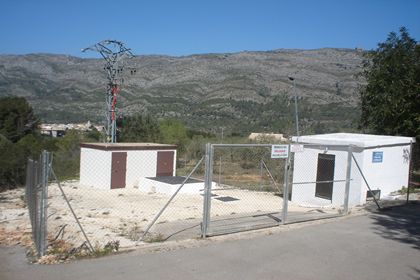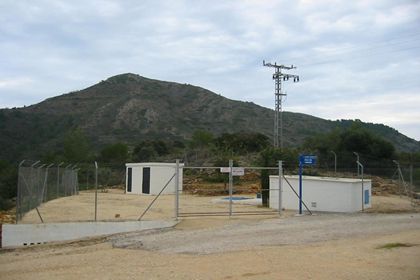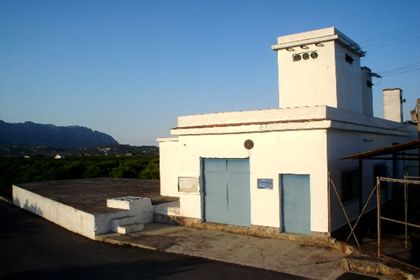Supply sources and installations
SOURCES OF DRINKING WATER SUPPLY FOR THE TOWN OF BENISSA.
The water the Benissa City Council provides for the drinking water supply is entirely groundwater. The supply wells are located in the municipal areas of Benidoleig, Benigembla and Benissa.
The main characteristics of each one are:
CAMI SANET WELL. Pinaret section (BENIDOLEIG)
In the Extraordinary Session of 29 April 1964, the Benissa City Council agreed to purchase 500 of the 3,000 total shares in a well located in the municipal area of Benidoleig (Alicante). In 2000 and 2001, the Benissa City Council purchased an additional 255 shares, and currently possesses 750 of the 3,000 total shares.
The well is located in the Girona river basin. The ownership title of the well is SAT No. 3498 POZO CAMINO DE SANET and is registered in the Catálogo de Aguas Privadas de la Confederación Hidrográfica del Júcar (Catalogue of Private Waters of the Júcar Hydrographic Confederation) under no. 463/1988 (1988IC1790), with a maximum volume of 548,000 m3/year. 160,000 m3/year of that volume are destined for irrigation and 388,000 m3/year are earmarked for supplying the town of Benissa.
To transfer the water to Benissa involved complicated negotiations with the Ministry of Public Works which finally resulted in approval for awarding the project of the drinking water supply to Benissa in 1967. Participants in the work were the Ministry, the Júcar Hydrographic Confederation and the citizens of Benissa through special taxes.
The installations the City Council has for transferring the water from Benidoleig consist of a facility with a 630 kVa transformer centre, two Worthington horizontal pumps with a 200 KW AEG motor, a control panel with two static starters and a chamber with a capacity of 300 m3.
The SAT (Sociedad Agraria de Transformación) deposits the water in the 300 m3 chamber adjacent to the well and by using the installed pumps pushes the water up to a chamber (Dura chamber) located on Mount Siguili, 280 metres above the mouth of the well. The impulsion system has a pressure switch installed which signals an alarm by remote control if the established pressure is not maintained due to a breakdown in the system. The water is transferred from the Dura chamber to the drinking water tanks of Benissa, located in the Collao section, by the force of gravity and a 300 mm diameter fibre cement pipeline running for 14.8 kilometres.
The installation has a volume meter which measures the outgoing water and another meter to record the incoming water in the 500 mm connection pipeline in the municipal area of Jalón. There is a remote control station which regulates the filling of the chamber next to the well, the hours of operation for the pumps and transfers the programmed alerts to the central facility and the operators involved.
Water quality is controlled through the analyses established in the protocol and the self-control and management of the Benissa water supply, which has been rated as satisfactory by the Environmental Quality section of the Regional Ministry for the Environment, Water, Development and Housing. In Benissa's case, that involves performing a complete analysis annually. The water is classified as drinkable.

SAN ANTONIO WELL, Garroferals section (BENIGEMBLA)
In the Session of 5 September 1972, the Benissa City Council reached an agreement, with Manolo Torres acting as the intermediary, to purchase the percussion-drilled wells of the Rey Hermanos company in the municipal area of Benigembla (Alicante), declaring the contract for purchasing it an extraordinary case. One of these wells was no. 3, the present-day San Antonio well.
The well is located in the Jalón Gorgos river basin. The ownership title of the well is the Benissa City Council, registered as no. 2005CP0016 of the Júcar Hydrographic Confederation, with the water used for supplying the town of Benissa.
To transfer the water to Benissa, a 350 mm fibre cement pipeline was built in 1976, paid for in full by means of special taxes on the residents of Benissa. In 2008, the Regional Ministry of Public Works, Development and Transport renovated the pipeline from Benigembla to Benissa, together with the network from Vall de Laguart to Calpe.
The installations the City Council has for transferring the water from the San Antonio well consists of a facility containing a 160 kVA transformer centre, a 150 HP Pleuger submersible pump, a manoeuvring control panel and a variable frequency drive. There is also an Aturia brand replacement pump in the town storage facility with the same technical characteristics as the installed pump.
The pump motor propels the water from the well to a chamber 66 metres higher than the mouth of the well. The water from the three wells the Benissa City Council owns in Benigembla join together there and the water is transferred to the drinking water tanks of Benissa, located in the Collao section, by the force of gravity and a 500 mm cast iron pipeline running for 14.8 kilometres. The impulsion system has a pressure switch installed which signals an alarm by remote control if the established pressure is not maintained due to a breakdown in the system.
The plot is fenced off and the mouth of the well protected by a cage. The installation has a volume meter which measures the outgoing water and another general meter at Collao to record the incoming water. There is a remote control station which regulates the hours of operation for the pumps and transfers the programmed alerts to the central facility and the operators involved.
Water quality is controlled through the analyses established in the protocol and the self-control and management of the Benissa water supply, which has been rated as satisfactory by the Environmental Quality section of the Regional Ministry for the Environment, Water, Development and Housing. In Benissa's case, that involves performing a complete analysis annually. The water is classified as drinkable.

MANUEL TORRES WELL, Llencas section (BENIGEMBLA)
In the Session of 5 September 1972, the Benissa City Council reached an agreement, with Manolo Torres acting as the intermediary, to purchase the percussion-drilled wells of the Rey Hermanos company in the municipal area of Benigembla (Alicante), declaring the contract for purchasing it an extraordinary case. One of these wells was no. 1, the present-day Manuel Torres well.
The well is located in the Jalón Gorgos river basin. The ownership title of the well is the Benissa City Council, registered as no. 2005CP0016 of the Júcar Hydrographic Confederation, with the water used for supplying the town of Benissa.
The well went into operation in 1985. As with the San Antonio well, a 350 mm fibre cement pipeline was built in 1976 to transfer the water to Benissa, paid for in full by means of special taxes on the town residents. In 2008, the Regional Ministry of Public Works, Development and Transport renovated the pipeline from Benigembla to Benissa, together with the network from Vall de Laguart to Calpe.
The installations the City Council has for transferring the water from the Manuel Torres well consists of a facility containing a 250 kVA transformer centre, a 230 HP Pleuger submersible pump, a control panel and variable frequency drive. It has a continuous water level meter installed, for the purpose of knowing what the water level is at all times and in order to protect the pump motor in case the level drops. There is also a Pleuger brand replacement pump in the town storage facility with the same technical characteristics as the installed pump.
The pump motor propels the water from the well to a chamber 50 metres higher than the mouth of the well. The water from the three wells the Benissa City Council owns in Benigembla join together there and the water is transferred to the drinking water tanks of Benissa, located in the Collao section, by the force of gravity and a 500 mm cast iron pipeline running for 14.8 kilometres. The impulsion system has a pressure switch installed which signals an alarm by remote control if the established pressure is not maintained due to a breakdown in the system.
The plot is fenced off and the mouth of the well protected by a cage. The installation has a volume meter which measures the outgoing water and another general meter at Collao to record the incoming water. There is a remote control station which regulates the hours of operation for the pumps and transfers the programmed alerts to the central facility and the operators involved.
Water quality is controlled through the analyses established in the protocol and the self-control and management of the Benissa water supply, which has been rated as satisfactory by the Environmental Quality section of the Regional Ministry for the Environment, Water, Development and Housing. In Benissa's case, that involves performing a complete analysis annually. The water is classified as drinkable.
The state government commission, in a session held 27 June 2000, adopted a measure naming well no. 1 in Benigembla as the Manuel Torres well in recognition of the decisive role he played in the acquisition of the wells in the Benigembla municipal area.

CORRALET WELL, Corralet section (BENIGEMBLA)
In 1986, the Benissa City Council reached an agreement, with Manolo Torres acting as the intermediary, to purchase the percussion-drilled wells of the Vegaiberica, S.A. company in the municipal area of Benigembla (Alicante). The wells are named Benigembla I (the present-day Boc Esmaig well) and Benigembla III (the present-day Corrales well). The wells were purchased by shares and the company promised a portion of them to the Benigembla City Council and SAT No. 733 of Benigembla.
In 1991, after intense negotiations and for the purpose of facilitating the operation of the wells, the co-ownership agreement was dissolved, with the Boc Esmaig well assigned to the Benigembla City Council and SAT no. 733 of Benigembla, and the Corralet well awarded to the Benissa City Council. A clause was agreed on whereby the Benissa City Council would provide additional water, as an auxiliary supply, in the event certain incidents might occur at the Boc Esmaig well.
The well is located in the Jalón Gorgos river basin. The ownership title of the well is the Benissa City Council, registered as no. 91-CP-0098 of the Júcar Hydrographic Confederation, with the water used for supplying the town of Benissa.
In 1996, the Regional Ministry of Public Works and Urban Development awarded the work for the installation of the Corralet well, carrying out the installation of the well and the pipeline joining it to the existing chamber into which the water from the San Antonio and Manuel Torres wells emptied. From that point, the water was transported via the 350 mm fibre cement pipeline built in 1976, which was paid for in full by means of special taxes on the residents of Benissa. In 2008, the Regional Ministry of Public Works, Development and Transport renovated the pipeline from Benigembla to Benissa, together with the network from Vall de Laguart to Calpe.
The installations the City Council has for transferring the water from the Corralet well consists of a facility containing a 400 kVA transformer centre, a 320 HP Pleuger submersible pump, and another building where control panel and a variable frequency drive are located. It has a continuous water level meter installed, for the purpose of knowing what the water level is at all times and in order to protect the pump motor in case the level drops. There is also a Pleuger brand replacement pump in the town storage facility with the same technical characteristics as the installed pump.
The pump motor propels the water from the well to a chamber 39 metres higher than the mouth of the well. The water from the three wells the Benissa City Council owns in Benigembla join together there and the water is transferred to the drinking water tanks of Benissa, located in the Collao section, by the force of gravity and a 500 mm cast iron pipeline running for 14.8 kilometres. The impulsion system has a pressure switch installed which signals an alarm by remote control if the established pressure is not maintained due to a breakdown in the system.
The installation has two volume meters which measure the outgoing water and the difference in potential supplies of water to help the town of Benigembla, and another general meter at Collao to record the incoming water. The plot is fenced off and the mouth of the well protected by a chamber. There is a remote control station which regulates the hours of operation for the pumps and transfers the programmed alerts to the central facility and the operators involved. It also has a motorised valve activated by remote control programming for supplying water to Benigembla if needed.
Water quality is controlled through the analyses established in the protocol and the self-control and management of the Benissa water supply, which has been rated as satisfactory by the Environmental Quality section of the Regional Ministry for the Environment, Water, Development and Housing. In Benissa's case, that involves performing a complete analysis annually. The water is classified as drinkable.

CANOR WELL, Canor section (BENISSA)
In 1984, the Benissa City Council requested a study from the Spanish Geological and Mining Institute (IGME) for the purpose of searching for supply sources within the municipal area. With the assistance of the Regional Public Works Ministry, eight exploratory wells were drilled at the sites indicated by the IGME and the best results were found in the Canor well.
The well is located in the aquifer of the Benissa Depression. The ownership title of the well is the Benissa City Council, registered as no. 2005CP0016 of the Júcar Hydrographic Confederation, with the water used for supplying the town of Benissa. In 1986, the installation work of the Canor well was carried out, as was the 300 mm pipeline from the well to the water tanks in Collao, with 60% of the cost subsidised by the Regional Ministry of Public Works.
The installations the City Council has for transferring the water from the Canor well consists of a facility containing a 160 kVA transformer centre, a 100 HP Pleuger submersible pump, and a control panel with a static starter. It has a continuous water level meter installed, for the purpose of knowing what the water level is at all times and in order to protect the pump motor in case the level drops. There is also a Pleuger brand replacement pump in the town storage facility with the same technical characteristics as the installed pump.
The pump motor propels the water directly from the well through a 300 mm fibre cement pipeline running for 4.1 kilometres to the drinking water tanks of Benissa, located in Collao.
The plot is fenced off and the mouth of the well protected with a covered chamber. The installation has a volume meter measuring the outgoing water.
Water quality is controlled through the analyses established in the protocol and the self-control and management of the Benissa water supply, which has been rated as satisfactory by the Environmental Quality section of the Regional Ministry for the Environment, Water, Development and Housing. In Benissa's case, that involves performing a complete analysis annually. The water is classified as drinkable.




 Castellano
Castellano  Valencià
Valencià  Deutsch
Deutsch  English (UK)
English (UK) 